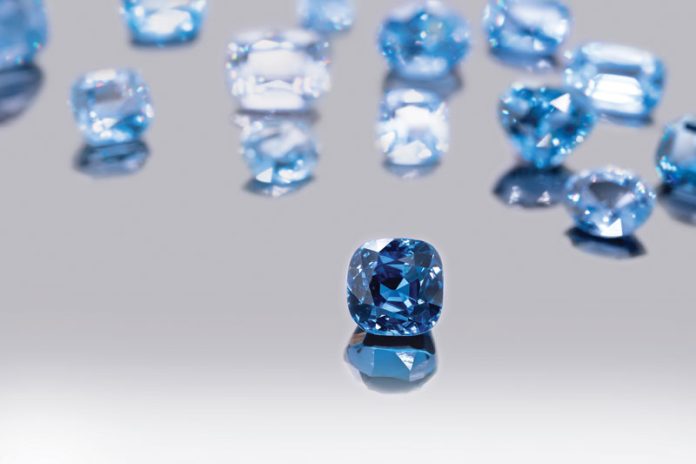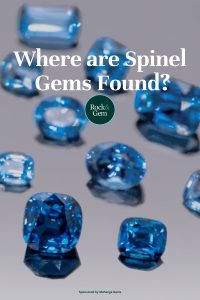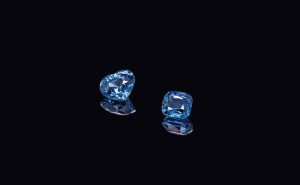
Where are spinel gems found? In the vibrant realm of colored gemstones, spinel holds an illustrious, yet surprisingly overlooked, position in the crown of beloved jewels throughout history. It’s the goal of Mahenge Gems to present this stone, along with some of the finest varieties of rubies, sapphires, garnets and tanzanite to the world’s gem market.

The Lure Behind Spinel
Beyond the visual appeal, colored gems make life beautiful. They are associated with positive aspects of life whether a wedding, birthday or the crown jewels of royalty. Spinel is high on many blue gems and minerals lists.
Regardless of the elaborateness, or simplicity, they are the brilliance of something good. This quality is not lost on Wez Barber of Mahenge Gems, a wholesale company that strives to connect gem dealers and artists with the high-quality gemstones that he and his partner, Rimsan Nifal, acquire directly from artisanal mines in Tanzania and Sri Lanka.
While they handle many varieties of colored gemstones, spinel holds a favored place for Mahenge Gems. “I like the story of it being the underdog,” explained Barber. “It’s always been undervalued and misunderstood. There is a mystique behind it.”
Derived from the Greek word for “spark,” spinel certainly earns its moniker with its vibrant color and brilliance. For centuries it was initially mistaken as a ruby and only recognized as its own mineral in 1783. Many of the world’s most illustrious “rubies,” are, in fact, spinel.
While it’s found in royal collections throughout the world, including the Diamond Fund which is a part of Russia’s jeweled past. One of the most famous pieces is the 170-carat “Black Prince’s Ruby,” which is actually a blood-red spinel. It was originally given to Edward of Woodstock, the “Black Prince,” in 1366. By 1415, King Henry V wore it into battle and nearly lost it and his life during the conflict.
It was a favorite piece of King Henry VIII and his daughter, Queen Elizabeth I. It currently resides in Britain’s Imperial State Crown in the Tower of London.
For centuries, spinel has been an underrated stone, even when it shares many of the positive characteristics in color, vibrance, and hardness (Mohs Scale of Hardness value of eight) as more popular gems. “It’s one of the easiest stones to cut, and strangely enough, it’s very forgiving,” said Barber.
 Where are Spinel Gems Found?
Where are Spinel Gems Found?
Depending on the percentage of chromium, iron, and cobalt influencing the stone, spinel is found in pinks, reds, and oranges to the hues of blues and violets. Found in Brazil, Kenya, and Vietnam, the Mahenge region of Tanzania is particularly well-known for this gemstone after the exciting discovery of the fiery pink spinel in 2007. But 2021 brought something completely different.
“In late October of last year this blue material came through the office doors,” said Barber. He said that Nifal immediately FaceTimed him to show him the new discovery. “He was so excited because of the color. It looks like a royal blue sapphire. He was like a kid in a candy shop with tears in his eyes.”
While there is a percentage of iron in the stone, Barber said, “It’s cobalt that gives it that electric blue. The color is stunning.”
This latest discovery is also larger than other cobalt spinel specimens found in other parts of the world. Barber said the material from Tanzania is coming out in two, three, and even four-carats in clear stones, which is undoubtedly exciting news for gem dealers.

A Business Built on Connections
Connecting high-quality gems, such as the cobalt spinel, with experts within the world of gemstones is the heart of Mahenge Gems.
“This business is entirely relation-based. It’s all about meeting people and doing business with people you like,” he said. “When we’re at the shows everyone gets together.”
This includes the partnership between Barber and Nifal who balance each other’s strengths and specialties. “(Nifal) looks after the sourcing. He can look at a piece of rough and know what is going to come from that stone,” said Barber. “I’m the guy who takes care of the marketing and the backend stuff.”
And for Mahenge Gems, the most important working relationships begin at the ground level with those who’ve mined these materials for generations. “Artisanal mining is very different. We have to look after the people in the supply chain,” he said. “We do what we can to give back. It can’t all be taken, take, take.”
The town of Mahenge was literally built on the mineral business, yet, in reality, this way of life is finite. Once these materials are extracted, they don’t grow back. Barber uses tanzanite as an example. The vibrant blue and purple-hued tanzanite exhibits pleochroism, the quality to display different colors depending on the angle of the stone, is unique to this region and, being identified in 1967, is one of the newest gems. Unfortunately, it’s not an unending source. “Tanzanite will be mined out in 20 years,” he said. With this knowledge, he feels it’s important to give miners a fair price within this mutually beneficial relationship.
Real-World Value
The other aspect of the gemstone industry that Barber appreciates is they are handling real, hard assets with a market value. This is not a fiat currency and there is nothing digital about holding a gemstone in your hand.
Whenever traditional markets waiver, hard assets surge ahead. “The stone market in gems is very strong,” explained Barber, who noted that people who are moving off the stock market are pushing prices of stones to record highs. Even with multiple supply chain issues, gem sales are strong. “In Sri Lanka, the price of sapphires has doubled in the last six months,” he said. And while he doesn’t expect it to last forever, it’s indicative of the appreciation and value of these high-quality gemstones.
When looking at the world of precious and semi-precious stones, diamonds have long received the glory, but is it well-earned?
As Barber points out, “Diamonds are judged on the absence of everything. Whereas colored gemstones are judged on the presence of everything.” From the local miners to the person who wears the finished jewelry, there is a presence of life in the stones brought to the world by Mahenge Gems.
This story about spinel gems previously appeared in Rock & Gem magazine. Click here to subscribe. Story by Amy Grisak. Sponsored by Mahenge Gems.















